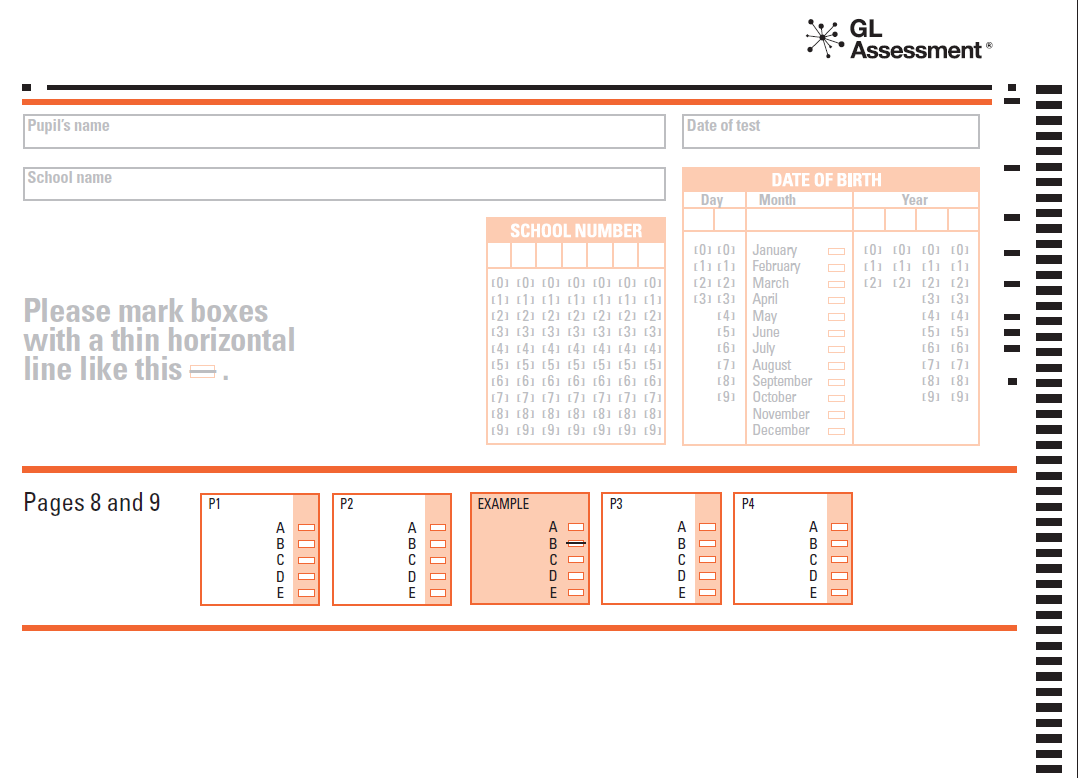There are two tests:
Mathematics: Papers are prepared specifically for the Consortium and are based on the Key Stage 2 curriculum. Click Here for Mathematics Familiarisation Paper
Verbal Reasoning: Click Here for Verbal Reasoning Familiarisation Paper
Key Points:
- Mathematics and Verbal Reasoning tests have pre-printed answer sheets with your child’s details and a unique test provider candidate number.
- Ensure your child answers on the answer sheet, not the question booklet, as the booklet is shredded and answers won’t be marked if written there.
- If answers are not recorded on the answer sheet, your child will receive a score of “0.”
Encourage your child to practice with the familiarisation papers and follow the instructions carefully.
There will be a short break between the tests for a small snack. Please avoid snacks containing nuts or that may contain nuts, including Nutella. Ensure the snack is suitable for a school environment.
CANDIDATE MUST BRING:
- Two pencils and a rubber.
CANDIDATES MUST NOT BRING:
- Any technology or web-enabled devices, including:
- iPods
- Mobile phones
- MP3/4 players
- Smartwatches
- Fitbits
- Wrist watches with data storage, cellular, or Bluetooth capabilities.
These items are not allowed in the test venue as per the Joint Council for Qualifications (JCQ) guidelines.
Note: An analogue rotary wristwatch is allowed but must be removed and placed on the desk before the exam starts.
Academic Ability Test Marking
The answer sheets are marked by a computer. They are machine-marked (scanned) and the computer detects the shading made on the answer sheets using OMR (Optical Mark Recognition) technology. Before taking the test, all children were provided with a Familiarisation Booklet to work through and this includes examples of how to record answers on the separate answer sheets. To do the test, children are told in the Booklet to:
“…read each question, chose the answer you think is correct and then put the answer on the separate answer sheet. When you have completed the test your answer sheets are then marked by a computer.”
Answer Sheet Instructions:
Marking Answers: Use a pencil to draw a line through the small rectangular box beside the correct answer.

Two Correct Answers: Some questions may require marking two answers. Be sure to read the instructions carefully.
Keep Your Place: Always check that you are marking the answer for the correct question number. This is especially important if you skip a question and return to it later.
Rough Working: You can use the question booklet for rough work, but do not write any working-out on the answer sheet.
Changing Answers: If you need to change an answer, erase the incorrect one completely and mark the correct answer. Do not cross out answers, as this will prevent the computer from marking them.
Example answer sheet:

To ensure that your child’s answers are correctly recognized during the scanning process:
Scanner Sensitivity: The scanning process will assess the size, sharpness, density, and position of the mark within the designated box. Make sure the marks are well-defined and placed within the correct area of the box.
Sufficient Shading: Each answer must be shaded clearly and fully. The mark needs to be dark enough for the scanner to recognize it.
How can I be sure that my child’s answer sheets have been marked correctly?
1.Unique Identification: Each answer sheet has a pre-printed pupil ID and barcode, linking your child’s answers to their record.
2. Online Keying Process:
- As answer sheets are scanned, the system flags any issues (e.g., unmarked or multiple marks).
- If an issue is detected, the scanning operator reviews the sheet and consults a supervisor if needed. Scanning resumes once the issue is addressed.
3. Handling Multiple Marks:
- The scanning software detects “multi-marks” (more than one mark in a box) and uses erasure discrimination to distinguish between genuine answers and erasures.
- If necessary, the operator checks whether a mark has been erased or if it’s a valid multi-mark. A supervisor may make the final decision. A record of any manual intervention is kept
4. Quality Assurance:
- Both the original and transcribed sheets are kept together for verification.
- If scanning issues occur, the operator manually transcribes the answers onto a new sheet, which is checked by another operator before being scanned.
Standardisation and Test Scoring:
Age-Standardised Scores: Raw scores in Verbal Reasoning and Maths are converted into age-standardised scores, taking the child’s age (in completed months) into account. This ensures fairness for children of different ages within the same year group.
For more on age-standardisation, see these resources:
Test Results:
Check Parent Portal: It is your responsibility to log in to the Parent Portal to view your child’s test results and other information within the provided timescales. Check the calendar for specific result release dates.
